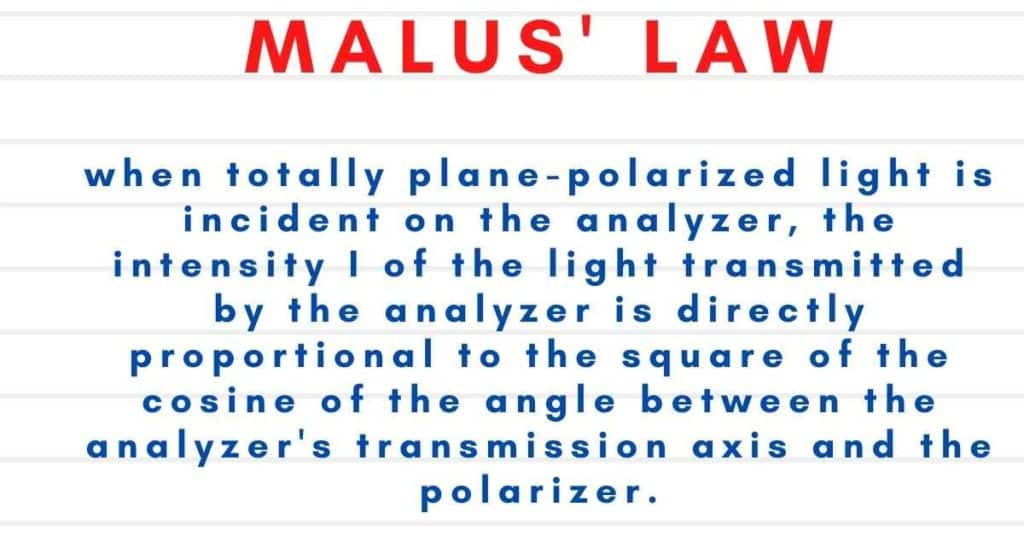According to Malus’ law, the intensity of plane-polarized light traveling through a polarizer is precisely proportional to the square of the cosine of the angle between the analyzer’s transmission axis and the polarizer.

When light strikes a polarizer, the polarised light is transferred. The polarised light that falls on another Polaroid, known as the analyzer, transmits light based on the orientation of its axis with respect to the polarizer. Malus’ law determines the intensity of light passed through the analyzer.
When unpolarized light from the Sun is dispersed over an angle of 90° by molecules in the atmosphere, it becomes almost fully polarised. On a sunny day, we frequently encounter the glare of reflected light from water or glass surfaces.
When a light beam strikes a material’s surface, some of the light is reflected and some are refracted (travels through the material). If the incident light is unpolarized, the reflected light will be horizontally polarised, parallel to the reflecting surface.
Malus Law Definition
According to Malus’ law, the intensity of plane-polarized light passing through a polarizer is proportional to the square of the cosine of the angle formed between the analyzer’s transmission axis and the polarizer.
Important Points
- If we wish to study or understand the polarization characteristics of light, we must first understand Malus law.
- The law assists us in studying the light intensity relationship of the polarizer-analyzer.
- Polarized light waves are light waves with vibrations that occur in a single plane. Polarization is the process of converting unpolarized light into polarised light.
- The main difference between polarised and unpolarized light is that polarised light contains electric fields that oscillate in just one direction, whereas unpolarized light has electric fields that oscillate in all directions.
Longitudinal waves, such as sound waves, cannot be polarised because particle motion is one-dimensional. As a result, because ultrasonic waves are sound waves, they cannot be polarised.
A polarizer is a device that filters light waves in order to produce polarisation. The primary distinction between a polarizer and an analyzer is that a polarizer generates plane polarised light, but an analyzer can determine whether or not the light has been polarised.
If the direction of this electric field varies randomly over time, light is said to be unpolarized. Unpolarized light is produced by many common light sources, including sunshine, halogen illumination, LED spotlights, and incandescent bulbs. Polarized light is characterized as having a well-defined electric field direction.
More Interesting Topics
Greenhouse Effect| Definition And 5 Key Factors
Crest of a Wave| Wave Properties
Biot Savart Law: Statement, Derivation & Applications
Transverse waves
Stationary Waves
Longitudinal Waves| Physics
- BCl3 Lewis Structure in four simple steps - November 1, 2023
- PH3 Lewis Structure in four simple steps - October 8, 2023
- PF3 Lewis structure in four simple steps - September 24, 2023



